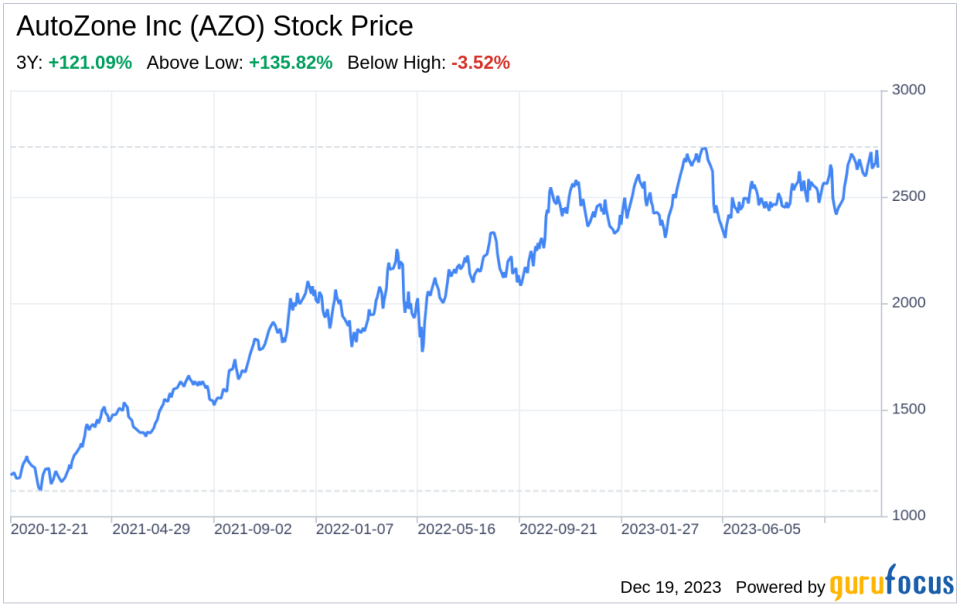Decoding AutoZone Inc (AZO): A Strategic SWOT Insight
AutoZone Inc (NYSE:AZO) showcases robust financial growth with net sales increasing by 5.1%.
Strategic expansion with new domestic and international stores contributing to revenue.
Effective management of operating expenses despite economic headwinds.
Commitment to shareholder value reflected in aggressive stock repurchase program.
AutoZone Inc (NYSE:AZO), a leading retailer and distributor of automotive replacement parts and accessories, has recently filed its 10-Q report on December 18, 2023. The filing reveals a company that continues to expand its footprint and solidify its market position. With a network of 7,140 stores across the U.S., Mexico, and Brazil, AutoZone has reported a net sales increase to $4.2 billion, up 5.1% from the previous year. This growth is driven by a 2.1% increase in same-store sales and the addition of new stores. Operating profit has surged by 17.4% to $848.6 million, and net income has climbed by 10.0% to $593.5 million. The company's financial health is further evidenced by a comprehensive income of $573.9 million and a cash flow from operations of $830.3 million. These figures underscore AutoZone's financial resilience and strategic prowess in a competitive industry.

Strengths
Robust Financial Performance: AutoZone Inc (NYSE:AZO) has demonstrated a strong financial performance with a 5.1% increase in net sales and a 10.0% rise in net income as reported in the latest 10-Q filing. The company's gross profit margin has improved to 52.8%, reflecting efficient cost management and favorable supply chain dynamics. This financial stability provides AutoZone with the flexibility to invest in growth initiatives and navigate economic fluctuations effectively.
Expansive Retail Network: With 7,140 stores across the U.S., Mexico, and Brazil, AutoZone boasts a vast and strategically located retail network. This extensive presence not only facilitates market penetration and customer accessibility but also enhances the brand's visibility. The addition of new stores has contributed significantly to the company's revenue stream, indicating a successful expansion strategy.
Shareholder Value Focus: AutoZone's aggressive stock repurchase program, with $1.5 billion spent on buying back shares in the reported period, reflects a strong commitment to delivering shareholder value. This strategy has not only supported the company's earnings per share but also signaled confidence in its long-term prospects.
Weaknesses
Dependence on Domestic Market: Despite its international presence, AutoZone still relies heavily on the U.S. market, which accounts for the majority of its sales. This concentration increases the company's vulnerability to domestic market risks, including economic downturns and regulatory changes. Diversifying revenue streams geographically could mitigate this risk and ensure more stable growth.
Increasing Debt Load: AutoZone's strategic initiatives and stock repurchases have been accompanied by an increase in debt. The company's long-term debt, including current maturities, stands at $5.2 billion, with a fair value estimated at $8.2 billion. While the company has the ability to refinance, the growing debt load could become a constraint if interest rates rise or if there are significant shifts in the credit markets.
Operational Costs: Operating, selling, general, and administrative expenses have increased, consuming 32.6% of net sales. This uptick is attributed to investments in domestic store payroll and technology. While these investments are necessary for growth and competitiveness, they also pressure profit margins and require careful management to maintain operational efficiency.
Opportunities
Market Expansion: AutoZone's growth trajectory presents opportunities for further expansion, particularly in emerging markets like Brazil, where the automotive aftermarket is growing. By capitalizing on the increasing demand for automotive parts and services in these regions, AutoZone can diversify its revenue base and reduce dependence on the U.S. market.
E-commerce Growth: The rise of online shopping offers AutoZone an opportunity to enhance its e-commerce platform, www.autozone.com. By investing in digital capabilities and omnichannel strategies, the company can capture a larger share of the online automotive parts market, catering to the evolving preferences of consumers.
Commercial Sales Program: AutoZone's commercial sales program has shown promising growth, with domestic commercial sales increasing by 5.7%. Strengthening this program can attract more business customers, such as repair garages and fleet owners, thereby boosting revenue and market share in the commercial segment.
Threats
Economic Uncertainty: Macroeconomic factors such as inflation, fuel costs, and supply chain disruptions pose threats to AutoZone's operations. These factors can affect consumer spending and lead to increased operational costs, impacting the company's profitability and growth prospects.
Competitive Pressure: The automotive parts industry is highly competitive, with numerous players vying for market share. AutoZone must continuously innovate and improve its product offerings and customer service to maintain its competitive edge and prevent loss of market share to rivals.
Regulatory Changes: The automotive industry is subject to stringent regulations, which can change and increase compliance costs. AutoZone must stay abreast of regulatory developments to avoid penalties and ensure that its products meet the required standards, which can be resource-intensive.
In conclusion, AutoZone Inc (NYSE:AZO) has demonstrated a strong financial performance with significant growth in net sales and net income. The company's expansive retail network and focus on shareholder value are key strengths, while its dependence
This article, generated by GuruFocus, is designed to provide general insights and is not tailored financial advice. Our commentary is rooted in historical data and analyst projections, utilizing an impartial methodology, and is not intended to serve as specific investment guidance. It does not formulate a recommendation to purchase or divest any stock and does not consider individual investment objectives or financial circumstances. Our objective is to deliver long-term, fundamental data-driven analysis. Be aware that our analysis might not incorporate the most recent, price-sensitive company announcements or qualitative information. GuruFocus holds no position in the stocks mentioned herein.
This article first appeared on GuruFocus.
